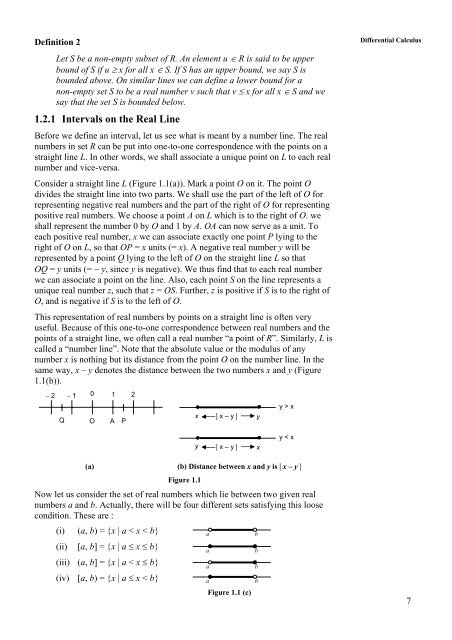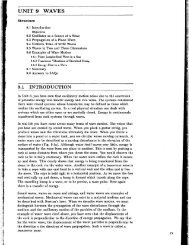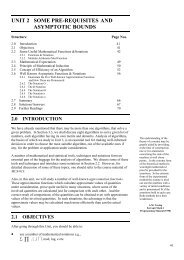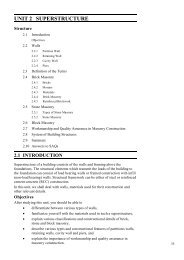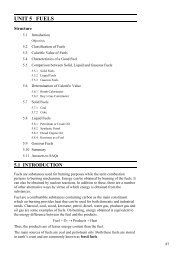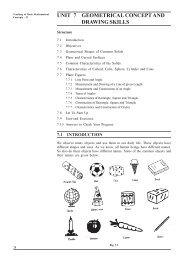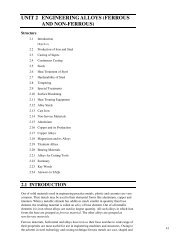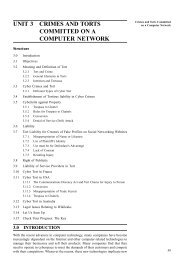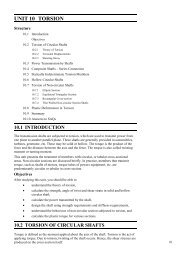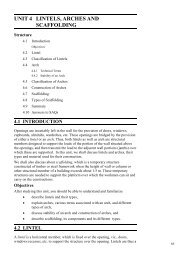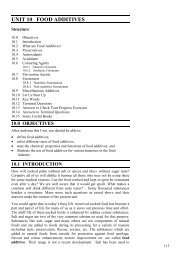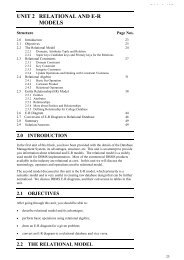unit 1 differential calculus - IGNOU
unit 1 differential calculus - IGNOU
unit 1 differential calculus - IGNOU
Create successful ePaper yourself
Turn your PDF publications into a flip-book with our unique Google optimized e-Paper software.
Definition 2<br />
Let S be a non-empty subset of R. An element u ∈ R is said to be upper<br />
bound of S if u ≥ x for all x ∈ S. If S has an upper bound, we say S is<br />
bounded above. On similar lines we can define a lower bound for a<br />
non-empty set S to be a real number v such that v ≤ x for all x ∈ S and we<br />
say that the set S is bounded below.<br />
1.2.1 Intervals on the Real Line<br />
Before we define an interval, let us see what is meant by a number line. The real<br />
numbers in set R can be put into one-to-one correspondence with the points on a<br />
straight line L. In other words, we shall associate a unique point on L to each real<br />
number and vice-versa.<br />
Consider a straight line L (Figure 1.1(a)). Mark a point O on it. The point O<br />
divides the straight line into two parts. We shall use the part of the left of O for<br />
representing negative real numbers and the part of the right of O for representing<br />
positive real numbers. We choose a point A on L which is to the right of O. we<br />
shall represent the number 0 by O and 1 by A. OA can now serve as a <strong>unit</strong>. To<br />
each positive real number, x we can associate exactly one point P lying to the<br />
right of O on L, so that OP = x <strong>unit</strong>s (= x). A negative real number y will be<br />
represented by a point Q lying to the left of O on the straight line L so that<br />
OQ = y <strong>unit</strong>s (= − y, since y is negative). We thus find that to each real number<br />
we can associate a point on the line. Also, each point S on the line represents a<br />
unique real number z, such that z = OS. Further, z is positive if S is to the right of<br />
O, and is negative if S is to the left of O.<br />
This representation of real numbers by points on a straight line is often very<br />
useful. Because of this one-to-one correspondence between real numbers and the<br />
points of a straight line, we often call a real number “a point of R”. Similarly, L is<br />
called a “number line”. Note that the absolute value or the modulus of any<br />
number x is nothing but its distance from the point O on the number line. In the<br />
same way, x – y denotes the distance between the two numbers x and y (Figure<br />
1.1(b)).<br />
− 2<br />
− 1<br />
0<br />
1 2<br />
Q O A P<br />
x | x – y | y<br />
y | x – y | x<br />
y > x<br />
y < x<br />
(a) (b) Distance between x and y is | x – y |<br />
Figure 1.1<br />
Now let us consider the set of real numbers which lie between two given real<br />
numbers a and b. Actually, there will be four different sets satisfying this loose<br />
condition. These are :<br />
(i) (a, b) = {x | a < x < b} a b<br />
(ii) [a, b] = {x | a ≤ x ≤ b} a b<br />
(iii) (a, b] = {x | a < x ≤ b} a b<br />
(iv) [a, b) = {x | a ≤ x < b} a b<br />
Figure 1.1 (c)<br />
Differential Calculus<br />
7


